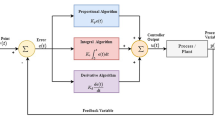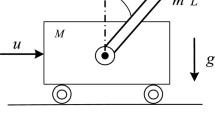Abstract
Pneumatic actuators find widespread use in industry when motion between two end-points is required, given their high power to weight ratio and low maintenance requirements. However, classical PID control of pneumatic actuators may present several undesired features, such as large steady-state errors. In this work, a two servo-valve architecture was developed for the position control of a servo-pneumatic system. With this architecture, the two servo-valves are independently controlled—the one connected to the charging chamber is controlled so as to maintain an approximately constant pressure in the discharging chamber, while the other handles motion control. The use of this control architecture is justified through analysis of the system model. By using this architecture with linear PID-family controllers, the aim is to enhance motion smoothness and improve the steady-state errors usually obtained with PID controllers in classical architectures, where the control actions are applied symmetrically to each servo-valve. Both simulation and experimental results show that the newly developed architecture compares very favorably to the classical one in terms of motion smoothness, steady-state positioning errors, and robustness to load variations.
Similar content being viewed by others
Abbreviations
- A A, B :
-
Piston area in chamber A,B (m2)
- A r :
-
Cross-sectional area of the rod (m2)
- A q :
-
Heat-transfer area of the actuator chamber (m2)
- C i :
-
Sonic conductance of orifice i (m3 Pa− 1 s− 1)
- c p :
-
Specific heat for constant pressure (J kg− 1 K− 1)
- c v :
-
Specific heat for constant volume (J kg− 1 K− 1)
- ε :
-
Error
- ε p :
-
Pressure error (Pa)
- ε s s :
-
Steady-state positioning error (m)
- ε x :
-
Positioning error (m)
- F :
-
Force (N)
- F e x t :
-
External force (N)
- F f r :
-
Friction force (N)
- K d :
-
Proportional acceleration gain (V m− 1 s− 2)
- K v e l :
-
Proportional velocity gain (V m− 1 s)
- K e p :
-
Proportional εpdch gain (V Pa− 1)
- K p :
-
Proportional pressure gain (Discharging Chamber) (V Pa− 1)
- K p o s :
-
Proportional positioning gain (V m− 1)
- K p r :
-
Proportional pressure gain (Charging Chamber) (V Pa− 1)
- K v :
-
Reference velocity feed-forward gain (V m− 1 s)
- λ 0 :
-
Equilibrium heat transfer coefficient (W m− 2 K− 1)
- \(\dot {m}\) :
-
Mass flow rate (kg s− 1)
- \(\dot {m}_{A,B}\) :
-
Mass flow rate entering/exiting chambers A,B (kg s− 1)
- \(\dot {m}_{A1,A2,B1,B2}\) :
-
Mass flow rate through restriction 1,2 of servo-valve A,B (kg s− 1)
- m :
-
Payload Mass (kg)
- n :
-
Polytropic index
- ρ :
-
Density (kg m− 3)
- p A, B :
-
Pressure in chamber A,B (Pa)
- p u i, d i :
-
Upstream/downstream pressure in orifice i (Pa)
- p a t m :
-
Atmospheric pressure (1 bar)
- p d c h :
-
Pressure in the discharging chamber (Pa)
- p r e f :
-
Pressure reference in the discharging chamber (Pa)
- p s :
-
Source pressure (7 bar)
- R :
-
Specific gas constant for air (ideal gas) (J kg− 1 K− 1)
- r :
-
Critical pressure ratio
- R 1,2 :
-
Restriction 1,2 of a servo-valve
- T A, B :
-
Temperature in chamber A,B (K)
- T a m b :
-
Ambient air temperature (K)
- T a :
-
Anti-windup parameter (reset time) (s)
- T a C l :
-
Anti-windup parameter (reset time) in classical PID (s)
- T i p :
-
Integrator time in the pressure controller (s)
- T i C l :
-
Integrator time in the classical PID controller (s)
- T s :
-
Supply air temperature (K)
- u A, B :
-
Control action applied to servo-valve A,B (V)
- x :
-
Position (m)
- x r e f :
-
Position reference (m)
- \(\dot {x}\) :
-
Velocity (m s− 1)
- \(\dot {x}_{ref}\) :
-
Velocity reference (m s− 1)
- \(\dot {x}_{est}\) :
-
Estimated velocity (m s− 1)
- \(\ddot {x}\) :
-
Acceleration (m s− 2)
- \(\ddot {x}_{est}\) :
-
Estimated acceleration (m s− 2)
References
Fujita T, Sakaki K, Makino F, Kikuchi T, Kagawa T, Kawashima K (2002) Accurate positioning of a pneumatic servo system with air bearings. In: Proceedings of the JFPS international symposium on fluid power, (5–3), pp 693–698
Wang Y, Su H, Harrington K, Fischer G (2010) Sliding mode control of piezoelectric valve regulated pneumatic actuator for mri-compatible robotic intervention. In: ASME 2010 dynamic systems and control conference, DSCC2010, vol 2, pp 23–28
Le MQ, Pham MT, Tavakoli M, Moreau R (2011) Sliding mode control of a pneumatic haptic teleoperation system with on/off solenoid valves. In: 2011 IEEE international conference on robotics and automation, pp 874–879
Zhang J-F, Yang C-J, Chen Y, Zhang Y, Dong Y-M (2008) Modeling and control of a curved pneumatic muscle actuator for wearable elbow exoskeleton. Mechatronics 18(8):448–457
Falcão Carneiro J, Gomes de Almeida F (2006) Reduced-order thermodynamic models for servo-pneumatic actuator chambers. Proc Inst Mech Eng, Part I: J Syst Control Eng 220(4):301– 314
Mehmood A, Laghrouche S, El Bagdouri M (2013) Nonlinear dynamic modeling of an electro-pneumatic pressure converter for vgt pneumatic actuator. Int J Autom Technol 14(6):941–953
Thomasset D, Scavarda S, Sesmat S, Belgharbi M (1999) Analytical model of the flow stage of a pneumatic servo-distributor for simulation and nonlinear control. In: Proceedings of the sixth Scandinavian international conference on fluid power. Tampere, Finland, May 26–28 1999, vol 3, pp 848–860
Falcão Carneiro J, Gomes de Almeida F (2011) Pneumatic servo valve models based on artificial neural networks. Proc Inst Mech Eng Part I: J Syst Control Eng 225(3):393–411
Carneiro JF, Gomes de Almeida F (2015) Lugre friction model: application to a pneumatic actuated system. In: Moreira A P, Matos A, Veiga G (eds) CONTROLO’2014—proceedings of the 11th Portuguese conference on automatic control. Springer International Publishing, pp 459–468
Mehmood A, Laghrouche S, El Bagdouri M, Ahmed F S (2010) Sensitivity analysis of lugre friction model for pneumatic actuator control. In: 2010 IEEE vehicle power and propulsion conference, pp 1–6
Rad C-R, Hancu O (2017) An improved nonlinear modeling and identification methodology of a servo-pneumatic actuating system with complex internal design for high-accuracy motion control applications. Simul Model Pract Theory 75:29–47
Saleem A, Taha B, Tutunji T, Al-Qaisia A (2015) Identification and cascade control of servo-pneumatic system using particle swarm optimization. Simul Model Pract Theory 52:164–179
Saleem A, Wong CB, Pu J, Moore PR (2009) Mixed-reality environment for frictional parameters identification in servo-pneumatic system. Simul Model Pract Theory 17(10):1575–1586
Falcão Carneiro J, Gomes de Almeida F (2012) A macro-micro motion servopneumatic device. Proc Inst Mech Eng I: J Syst Control Eng 226(6):775–786
Falcão Carneiro J, Gomes de Almeida F (2012) A high-accuracy trajectory following controller for pneumatic devices. Int J Adv Manuf Technol 61(1):253–267
Falcão Carneiro J, Gomes de Almeida F (2014) Micro tracking and positioning using off-the-shelf servopneumatics. Robot Comput-Integr Manuf 30(3):244–255
Falcão Carneiro J, Gomes de Almeida F (2015) Accurate motion control of a servopneumatic system using integral sliding mode control. Int J Adv Manuf Technol 77(9):1533–1548
Rao Z, Bone GM (2008) Nonlinear modeling and control of servo pneumatic actuators. IEEE Trans Control Syst Technol 16(3):562–569
Sorli M, Gastaldi L (2009) Thermic influence on the dynamics of pneumatic servosystems. J Dyn Syst Meas Control 131(2):024501
Falcão Carneiro J, Gomes de Almeida F (2013) Using two servovalves to improve pneumatic force control in industrial cylinders. Int J Adv Manuf Technol 66(1):283–301
Smaoui M, Brun X, Thomasset D (2005) A combined first and second order sliding mode approach for position and pressure control of an electropneumatic system. In: Proceedings of the 2005, American control conference 2005, vol 5, pp 3007–3012
Girin A, Plestan F, Brun X, Glumineau A (2009) High-order sliding-mode controllers of an electropneumatic actuator: application to an aeronautic benchmark. IEEE Trans Control Syst Technol 17(3):633–645
Slotine J-JE, Li W (1990) Applied nonlinear control. Prentice Hall, Englewood Cliffs
Ning S, Bone GM (2002) High steady-state accuracy pneumatic servo positioning system with pva/pv control and friction compensation. In: Proceedings 2002 IEEE international conference on robotics and automation (Cat. No.02CH37292), vol 3, pp 2824–2829
Fok SC, Ong EK (1999) Position control and repeatability of a pneumatic rodless cylinder system for continuous positioning. Robot Comput Integr Manuf 15(5):365–371
Situm Z, Pavkovic D, Novakovic B (2004) Servo pneumatic position control using fuzzy PID gain scheduling. J Dyn Syst Meas Control 126(2):376–387
Salim SNS, Rahmat MF, Faudzi AMA, Ismail ZH, Sunar N (2013) Position control of pneumatic actuator using self-regulation nonlinear PID. Math Probl Eng, vol 2014. https://www.hindawi.com/journals/mpe/2014/957041/cta/
Chiou J-S, Tsai S-H, Liu M-T (2012) A PSO-based adaptive fuzzy PID-controllers. Simul Model Pract Theory 26:49–59
Chang W-D (2013) Nonlinear CSTR control system design using an artificial bee colony algorithm. Simul Model Pract Theory 31:1–9
Stojanovic V, Nedic N (2015) Robust identification of oe model with constrained output using optimal input design. J Frankl Inst 353:576–593
Stojanovic V, Filipovic V (2014) Adaptive input design for identification of output error model with constrained output. Circ Syst Signal Process 33(1):97–113
Filipovic V, Nedic N, Stojanovic V (2011) Robust identification of pneumatic servo actuators in the real situations. Forsch Ingenieurwes 75(4):183–196
Stojanovic V, Nedic N, Prsic D, Dubonjic L, Djordjevic V (2016) Application of cuckoo search algorithm to constrained control problem of a parallel robot platform. Int J Adv Manuf Technol 87(9):2497–2507
Pršić D, Nedić N, Stojanović V (2017) A nature inspired optimal control of pneumatic-driven parallel robot platform. Proc Inst Mech Eng C J Mech Eng Sci 231(1):59–71
Falcão Carneiro J, Gomes de Almeida F (2016) On the influence of velocity and acceleration estimators on a servopneumatic system behaviour. IEEE Access 4:6541–6553
Carneiro J, Almeida Fernando (2012) A neural network based nonlinear model of a servopneumatic system. J Dyn Syst Meas Control 134:024502
Canudas de Wit C, Olsson H, Astrom KJ, Lischinsky P (1995) A new model for control of systems with friction. IEEE Trans Autom Control 40(3):419–425
ISO 6358 (1989) Pneumatic fluid power—components using compressible fluids—determination of flow-rate characteristics. International Society for Standardization (ISO), Geneva
Brun X, Sesmat S, Thomasset D (2005) Study of sticking and restarting phenomenon in electropneumatic positioning systems. J Dyn Syst Meas Control 127(1):173–184
Åström KJ, Hägglund T (1995) PID controllers: theory, design, and tuning. Isa Research, Triangle Park
Ogata K (2001) Modern control engineering, 4th edn. Prentice Hall PTR, Upper Saddle River
Carneiro JF, Gomes de Almeida F (2011) Undesired oscillations in pneumatic systems. Springer, Netherlands, pp 229– 243
Funding
The authors gratefully acknowledge the funding of Project NORTE-01-0145-FEDER-000022 - SciTech - Science and Technology for Competitive and Sustainable Industries, co-financed by Programa Operacional Regional do Norte (NORTE2020), through Fundo Europeu de Desenvolvimento Regional (FEDER).
Author information
Authors and Affiliations
Corresponding author
Additional information
Publisher’s Note
Springer Nature remains neutral with regard to jurisdictional claims in published maps and institutional affiliations.
Rights and permissions
About this article
Cite this article
Dólleman, P., Carneiro, J.F. & Gomes de Almeida, F. Exploring the use of two servo-valves for servo-pneumatic control. Int J Adv Manuf Technol 97, 3963–3980 (2018). https://doi.org/10.1007/s00170-018-2230-4
Received:
Accepted:
Published:
Issue Date:
DOI: https://doi.org/10.1007/s00170-018-2230-4




